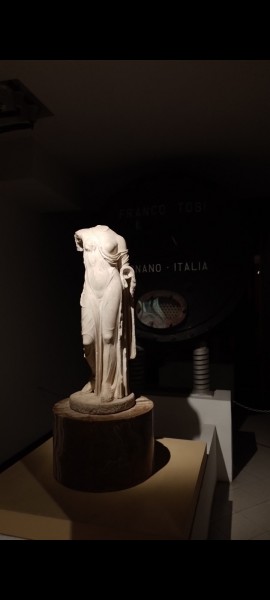 I study archaeology within my anthropology major, and while I'm hardly doing much on-site excavations here, there's a kind of symbolic excavation Collu's renovations are doing. Peeling back the layers of art for what it's "really" about. When I was an angsty middle-teenager, I used to say that symbolism finds its way into the world in mysterious ways. Since, I've pieced together that, more accurately, people just have a knack for pattern recognition, and we'll look for patterns anywhere we can. The symbols that show up around us are there because something in us wanted to see them there. Collu's exhibition is a museum-sized exercise in symbolic pattern recognition.
I study archaeology within my anthropology major, and while I'm hardly doing much on-site excavations here, there's a kind of symbolic excavation Collu's renovations are doing. Peeling back the layers of art for what it's "really" about. When I was an angsty middle-teenager, I used to say that symbolism finds its way into the world in mysterious ways. Since, I've pieced together that, more accurately, people just have a knack for pattern recognition, and we'll look for patterns anywhere we can. The symbols that show up around us are there because something in us wanted to see them there. Collu's exhibition is a museum-sized exercise in symbolic pattern recognition.
A few days ago, we visited another notable art gallery in Rome. It's housed within the engine and boiler rooms of the first power plant constructed in Rome. Built in the early 20th century, the plant was originally placed on the outskirts of the city. But as Rome expanded over the course of the next hundred years, the power plant was eventually swallowed by the rapidly spreading periphery of the city and was eventually decommissioned. And now, the empty husk of the Centrale Montemartini power plant sits in the center of the neighborhood of Ostiense as a relic of a bygone period in Italy's history. We were brought there as an on-site visit for a class of mine. (Ancient Romans at Work and Play. Awesome class.)
The art gallery is jarring. On the first floor, an ancient and decrepit statue of Venus, the Roman goddess of love, beauty, and victory, is positioned in front of a blackened coal engine. A quarter of the first floor's surface area is made up of a dormant mechanical monster that stretches from floor to ceiling and up through to the second floor. Up two flights of grated steel stairs, one discovers that this organ of the factory is the colossal gears of a pair of mega-engines. It's hard to tell whether the marble-tiled floors and the statues of emperors and the Roman pantheon are out of place among the machines or vice versa. One reels trying to reconcile the object to their left with the object to their right being in the same room.
The image of Venus in front of the coal engine followed me upstairs. I wish I could explain why the image was so striking to me, but I was in a daze as I thought about the goddess of beauty standing almost defensively in front of a rusted fossil of bygone industrial fervor. I could picture her coming alive in the night and spreading rust around the centrifuges, and I could picture Hermes leaping along the turbines as if it were a game of hopscotch. Somewhere in there, I think in the control room not far from the boiler, I saw a statue of Romulus, founder of Rome, and I could picture him sharing an aperol spritz with a Roman freedman as they wandered through the museum. I pictured the bust of Cleopatra chattering by the cracked marble foot of a colossal statue of Athena, who's lounging against one of the upright boilers.
There's something symbolic (well, "symbolic") to the cracks in the marble statues matched with the rusted machinery in Centrale Montemartini. From phone charger vendors near ancient hospitals to pizzerias in sight of the Roman Senate. Rust sits on the machinery behind a Venus statue who looks at you like she's taunting you. I wonder if the goddess of beauty living in the same room as rusted machinery even needs to be an oxymoron—maybe rust is just beautiful, and maybe Cristiana Collu would put the Centrale Montemartini power plant in the same room as a dilapidated statue of Venus, too. In both museums, time dissolves like salt in water. And Rome mirrors that phenomenon: here, time is scrambled around you. It's hard to tell what era you're living in at any given moment. And when you put Venus next to Centrale Montemartini, you wonder if there are ever any victims of the passage of time at all. Maybe they're just subjects. Growth in any direction is still growth, right?
Looking forward to traversing more of Rome's history, even if it's been thoroughly tossed like a salad. Until the next entry!
From Kenyon:
This was the post that inspired the introductory post to the series, and this was also the experience that first made me actually think about the subject of tangible history in Rome and how confusing it actually is when you look around. The city's 3,000 years old. And there are ruins in the city that come from all throughout its inhabitation. The entire city's a kind of museum, or maybe a broken time machine. It seems that all of time is suddenly unspooled in front of you. It first hits you like TV static—overwhelming and disorienting—but after some time, it settles instead into a gorgeous collage. I still couldn't tell you why the decrepit statue of Venus situated in front of the coal burner has stuck with me so much. She was cracked all over, her head and one of her arms missing, made of a gorgeous white marble (but was painted vividly back when she was new), and standing elegantly on a pedestal. The coal burner, on the other hand, was rotund, black, and held together by industrial bolts positioned in a circle so perfectly measured out it's hard to remember that humans made it with their own hands. And the two were both relics of their respective periods, and they were less than 10 feet from one another. The fact that they occupied the same space at all is representative of Rome's material culture, but the fact that, in my mind at least, the two contrasted with each other into a really pretty image is suggestive even more so of Rome's beauty.
Later on in the semester, I wound up doing a storybook project for my Italian Art and Design class, wherein I wrote a short illustrated book (illustrations were watercolor) about the Centrale Montemartini power plant. I spent a couple hours on the painting of Venus.
I also mentioned in the post something about the gigantic foot of Athena in the museum. I really want to nail in again just how huge that thing was. My friends and I couldn't stop laughing. We spent way too much time just lounging around the goddess Athena's foot. It was a fun trip.


 I study archaeology within my
I study archaeology within my